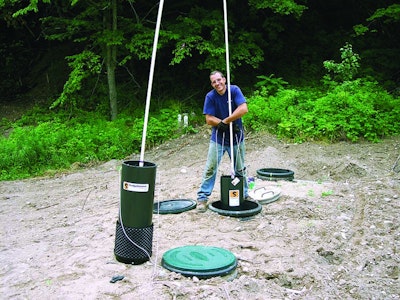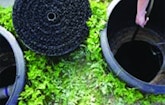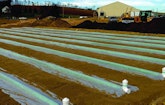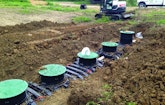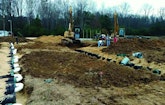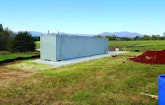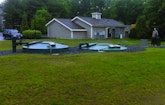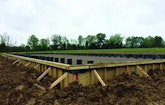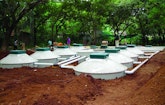Interested in Systems/ATUs?
Get Systems/ATUs articles, news and videos right in your inbox! Sign up now.
Systems/ATUs + Get AlertsCluster system allows resort to reclaim effluent for irrigation
Problem: A resort in Costa Rica was using seepage pits to dispose of effluent. The owners wanted to reclaim the water for spray irrigation. They were using potable water for irrigation and had a monthly water bill of more than $3,300.
Solution: Pacific Aqua Systems installed eight AERO-TECH 1,500 gpd aerobic treatment units in a cluster design. They are designed to treat wastewater to NSF Standard 40 requirements with little maintenance. The treated water from the 12,000 gpd system was disinfected and returned to the irrigation tank.
Result: The system allowed the resort owner to increase spraying and lower the monthly water bill. The treated water is tested weekly, with results of less than 1 mg/L of TSS, BOD and CBOD. 574/935-0908; www.aerotech-atu.com.
Control panel helps achieve efficiencies at football stadium
Problem: Observing an efficiency issue during install of a control panel associated with wastewater handling, an electrician for the Minnesota Vikings’ new stadium in Minneapolis double-checked the design, and informed the contractor of an issue. A Check It Series Panel from Alderon Industries was recommended for the situation.
Solution: A low-cost strategy was quickly redesigned to include an optional seal fail and thermal cutout into the original panel design to provide longer runtime and shelf life. The field-adaptable, expandable panel has individually labeled floats, terminals and switches, one-button self-diagnostic Check It switch, individual HOA switches, and UL-listed NEMA 1/4X enclosure to reduce install and service time, and diagnose electrical wiring, float operation and installation. The panel monitors and alerts users to high levels or pump failures in water or wastewater applications, and alternates pump commands.
Result: The solution saved several weeks and thousands of dollars on the stadium project. 218/483-3034; www.alderonind.com.
Treatment solution designed to meet environmentally sensitive standards
Problem: As a result of stringent environmental standards of Canada’s provincial Manitoba Conservation, the lodge owners of Quesnel Lake Caribou Lodge needed to upgrade their wastewater system. With no access to a municipal sewer system and no power source available, the treatment system required high efficiency with very low power consumption.
Solution: Installation was done in two stages, the first of which employed the existing ejector system. This was accomplished using two Anua Platinum 24 submerged aerated treatment units, along with a 2,000-gallon pump tank. This allowed the use of an ejector for the first season and, by substantially reducing the effluent strength, a temporary license was awarded for that season. The second phase involved erecting a raised mantle portion of the area bed along with 16 Puraflo modules.
Result: Installing the two Platinum treatment units reduced the size and quantity of materials required for construction. A sequencing valve was installed, ensuring the system was only pumping to four Puraflo units at a time, reducing the cost and complexity of the system. 336/547-9338;
www.anuainternational.com.
New system incorporates elements of existing treatment infrastructure
Problem: Barrel House Brewery is a commercial craft beer brewery in Virginia. Citing a lack of treatment capacity and given the high-strength wastewater generation common to craft beer production, the local public sewer was unable to receive the brewery’s wastewater. Therefore, the brewery discharged to an onsite aerobic treatment system, which suffered a drainfield failure.
Solution: The owner reached out to Apptech Solutions for guidance. After completing a pilot study that focused on the business’ unique water chemistry, Apptech developed a custom-engineered solution using the Mobile Inceptor treatment system designed to serve current needs and provide the foundation for future expansion. The engineered solution incorporated infrastructure that the owner had already invested in. The primary clarifier was left in service, the effluent pump station was converted to an influent pump station, and the aerobic treatment units were repurposed as sludge holding tanks. The system included flow equalization, multistage aerobic treatment with membrane filtration, an effluent pump station and a controls and equipment room.
Result: The system is now producing effluent far exceeding permit limits. 540/380-5600; www.apptech-solutions.com.
Clustered system helps condominium achieve total nitrogen permit standard
Problem: In 2007, a small condominium trust in Stow, Massachusetts, was forced to replace its wastewater treatment system to meet a permit standard of less than 10 mg/L total nitrogen. The trust was concerned with capital equipment and life cycle operating costs as well as process reliability.
Solution: The trust’s engineer recommended replacing the system with a two-stage Bioclere trickling filter system followed by an anoxic AquaCELL moving bed biofilm reactor for denitrification from Aquapoint. The design included a primary tank, which also serves as a pre-anoxic zone and for sludge holding, and an equalization tank to regulate flow through the treatment process. Chemical-feed systems were also installed to restore alkalinity and provide carbon to the post-anoxic zone.
Result: The 12,000 gpd system has been in consistent compliance for nearly 10 years, operating at a fraction of the cost of the previous activated sludge system. Performance averages are 10.5 BOD, 5.2 TSS and 3.7 TN. 508/985-9050; www.aquapoint.com.
Gravel filters help lower treatment costs
Problem: The people of Hayden, Indiana, were faced with a dilemma. Failing septic systems were becoming an issue, and seemingly the only solution was to move the waste from the homes to be treated at another location. Hiring The Lochmueller Group for a solution, the township was presented with different alternatives, including a conventional sewer and treatment plant, or a decentralized treatment system.
Solution: Working with Watermark Engineering, the decision was made to install two large gravel filters from Clarus Environmental.
Result: The filters enable the residents of Hayden to have their waste treated at an overall lower cost to the town. 800/928-7867; www.clarusenvironmental.com.
Upgrade aims to extend life of single-chamber septic system
Problem: In June 2014, ESSE Canada, an onsite system installer in Ontario, Canada, identified a residential customer looking for a preventive upgrade to extend the life of their existing septic system.
Solution: A ClearPod was placed into the single-chamber septic system (800-gallon tank) with an effluent filter. The system receives annual maintenance checkups to ensure it is operational.
Result: Recent wastewater sampling indicates effluent of 8.8 mg/L CBOD and 7 mg/L TSS. The results indicate an approximate removal rate of BOD/TSS of 90 to 95 percent and significantly reduced loading to the leachfield, and will significantly improve hydraulic flow, extending the life of the system. This is expected to eliminate the chance for leachfield failure, repair or replacement. 819/598-7153; www.clearpodwater.com.
System effective for market with poor soil conditions
Problem: A food market in north-central Pennsylvania needed to repair its septic system after it malfunctioned. Plans to expand the facility were also factored into the repair. The site had multiple constraints, including a 20-inch limiting factor (bedrock) as well as poor soils (127 mpi). Because of this, a traditional system or elevated sand mound would not fit on the site.
Solution: The designer specified an Eljen GSF bed system for the site, using 192 B43 modules and a dual-compartment tank for the 1,250 gpd system. The system used low-pressure distribution by putting a 1.5-inch pressure lateral into the 4-inch SDR 35 perforated pipes that sit on top of the GSF modules. The bed was separated into two zones, each 48 feet wide by 97.5 feet long, that were alternately dosed.
Result: The owners were able to expand the market and still meet the multiple site constraints with a system that is able to treat effluent to NSF Standard 40, has lower material costs, and requires no annual maintenance or media replacement in the future. 800/444-1359; www.eljen.com.
MBRs enable strip-mining site to become resort
Problem: Giant Goose Ranch is a reclaimed strip-mine property in Fulton County, Illinois, covering more than 800 acres and with more than 50 lakes famous for fishing. Plans to rehab an existing campground to add resort cabins and 90 campsites required a new wastewater treatment system. The inconsistent soils, lakes, drastic elevation changes, and stringent code requirements challenged system designer Ray Tebo of New Excavating Technology.
Solution: The water-recycling membrane systems designed include Bio-Microbics BioBarrier Membrane systems installed within Infiltrator Water Technologies IM-Series tanks. The numerous MBRs are either 500 or 1,000 gpd units built to suit the location; single units serve individual cabins and 1,000 gpd MBRs serve clusters of resort cabins, beach houses, a store and a banquet hall. IM-Series tanks are also used for trash and pump tanks. Dispersal fields are time-dosed by Aquaworx IPC control panels. A blower outside the tanks blows air to scour clean the membrane, which keeps the biomass alive and growing. A 1.5-amp marine pump attached to each MBR slowly pulls the recycled water out and then transitions to gravity flow to the dispersal fields.
Result: Installing the tanks allowed offsite assembly of the units and delivery and installation without a heavy boom truck, resulting in substantial cost savings. EZflow by Infiltrator was used for the treated effluent dispersal fields, eliminating heavy trucking and the spreading and compaction challenges of stone. 800/221-4436; www.infiltratorwater.com.
System helps facility meet higher summer discharge levels
Problem: Crossville Health and Rehab in DeKalb County, Alabama, had a lagoon system that retained and partially treated 12,000 gpd. The effluent was discharged into a nearby stream. During the summer months the stream had minimal flows, resulting in higher discharge standards set by Alabama Department of Environmental Management. The system could not meet the required treatment levels during this time of year and fines were imposed.
Solution: The nursing home hired Judith Pike, P.E., from Highland Technical Engineering. She explored many options before deciding on AES from Presby Environmental for its onsite treatment system. Space, cost and maintenance were among the deciding factors. The facility generated two separate flows from the building, which was easily handled with the AES system and design. The system consisted of three beds — two treating 5,000 gpd each and a third that treats 2,000 gpd. The total amount of AES pipe used for this application was 6,400 feet. The two larger beds were installed using a sloping bed method; the smaller bed was installed level.
Result: The system saved the facility money, space and maintenance fees, while maintaining treatment levels set by the state. 800/473-5298; www.presbyeco.com.
Strict disinfection needs solved at oceanfront Malibu restaurant
Problem: Located on the oceanfront in Malibu, California, Duke’s is a popular restaurant, named for Duke Kahanamoku, the father of surfing. Wastewater from the restaurant averages 6,000 gpd, and must be treated on site and directly discharged to the sensitive sandy beach environment. The existing wastewater treatment system was outdated and causing numerous water-quality and discharge violations.
Solution: Carlile-Macy was selected to provide an upgraded treatment system in 2011. They chose an upflow sludge blanket filtration system, USBF, and Salcor UV disinfection, consisting of four 3G units in two parallel tracks. The design was approved by the California Regional Water Quality Board and city of Malibu, and construction of the new plant was completed in April 2012.
Result: The system immediately produced high-quality effluent, which met the stringent disinfection requirement of California Title 22. Results have been consistent since operation began. Effluent total coliform count has been non-detectable, and the dissolved oxygen concentration has averaged 6 mg/L. The discharge has reduced coliform levels in the groundwater lens under the site and adjacent beach from more than 1,600 MPN to less than 2 MPN. The UV units were initially inspected weekly for possible fouling of the Teflon barrier. Since no fouling has occurred, the inspections have been eliminated. 760/731-0745.
System allows restaurant to treat effluent without need for leachfield
Problem: Legs Inn in Harbor Springs, Michigan, is a restaurant serving over 500 meals a day. It discharges almost 6,000 gpd of high BOD effluent, and is located on Lake Michigan. The leachfield had failed, and the restaurant needed a quick, efficient solution. The old system consisted of two 1,200-gallon grease traps from the kitchen leading to a 2,500-gallon septic system for the domestic waste. This flowed to a lower siphon tank to the leachfield downhill. The system was woefully undersized given the load.
Solution: SludgeHammer Group designed a system that would treat the effluent to the level necessary to abandon the leachfield and install a subsurface Geoflow drip irrigation field. A 2,500-gallon grease trap was added next to the others, and eight 4,000-gallon single-chamber treatment tanks were added in series for the S-86 Aerobic Bacterial Generator treatment units to be installed. A final 4,000-gallon pump tank was installed to supply the dripfield. A 15,000-square-foot dripfield with 7,600 feet of dripline with emitters on 2-inch centers was installed over the old leachfield. The lines were laid so they drained back to the pump tank to avoid freezing.
Result: Samples are taken annually with BOD typically below 10 mg/L, so the dripfield is protected. The restaurant is seasonal, so recycled water from the lower tanks is used to flush and treat the grease trap in winter to eliminate the need for grease pumping. 800/426-3349; www.sludgehammer.net.
